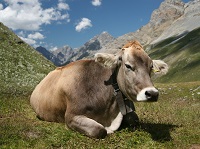-

Water troughs are key to E. coli contamination in cattle
A major study led by Cornell University College of Veterinary Medicine researchers reveals for the first time that water troughs on farms are a conduit for the spread of toxic E. coli in cattle, which can then spread the pathogen to people through bacteria in feces. The study was recently publish...Read more -

Drug-resistant genes spread through environment, not meat products
In the first study to track antibiotic resistance in intensively-farmed beef, scientists discovered a “startling” lack of resistance genes in meat. Meanwhile, in soil and faeces samples from cattle pens they found genes resistant to a powerful “last resort” class of antibi...Read more -
Challenges for controlling bovine tuberculosis in South Africa
All effects taken together, bovine tuberculosis (bTB) has a long-term detrimental effect on bovine herds and many wildlife species in South Africa. The disease is not only found in domestic cattle but also in African buffaloes and has to date been diagnosed in 21 wildlife species, including sever...Read more -
Bovine rumen impaction caused by ingestion of Gonometa postica cocoons in eastern-central Namibia
Cases of rumen impaction caused by ingestion of Gonometa postica cocoons occurred at a farm in eastern-central Namibia. Ten animals died on the farm over the previous 5 months. Rumenotomies were successfully performed on three affected animals. The authors were of the opinion that the affected an...Read more -
Newly discovered infectious prion structure shines light on mad cow disease
Groundbreaking research from the University of Alberta has identified the structure of the infectious prion protein, the cause of “mad cow disease” or BSE, chronic wasting disease in deer and elk and Creutzfeldt-Jakob disease in humans, which has long remained a mystery. The infectiou...Read more -

Insecticide treatment of cattle to kill sand flies and combat leishmaniasis
With an estimated 500,000 human infections and 50,000 deaths annually, visceral leishmaniasis (VL) is the second most prevalent parasitic killer, behind malaria. Leishmania parasites are transmitted through the bite of phlebotomine sand flies. A study published in PLOS Neglected Tropical Diseases...Read more -

How to Improve Pregnancy Rate in Dairy Cattle
Research at the University of Illinois has shown that adding methionine to the diets of Holstein cows during the prepartum and postpartum periods may impact the preimplantation embryo in a way that enhances its capacity for survival. “Methionine is the first limiting amino acid for dairy ca...Read more -

Feeding food waste to pigs could save vast swathes of threatened forest and savannah
A new study shows that if the European Union lifted the pigswill ban imposed following 2001′s foot-and-mouth disease epidemic, and harnessed technologies developed in East Asian countries for ‘heat-treating’ our food waste to safely turn it into pig feed, around 1.8 million hect...Read more -

Doctors call on hospitals to oppose the overuse of antibiotics in animal agriculture
To help stop the spread of antibiotic resistance, UC San Francisco scientists are urging hospitals around the country to stop buying meat from animals that were given antibiotics for growth promotion. For the last two years, UCSF Medical Center has been phasing out meat from animals that were rou...Read more -

Evidence that an Influenza A virus can jump from horses to camels
University of Florida researchers have found evidence that an influenza A virus can jump from horses to camels — and humans could be next. The One Health Center of Excellence for Research and Training in UF’s Emerging Pathogens Institute, in collaboration with U.S. and Mongolian insti...Read more -

Equine specialist warns horse owners of dangerous virus
A Kansas State University equine specialist is warning horse owners of a highly contagious virus recently identified in Kansas and Wisconsin. The Kansas Department of Agriculture reports that a horse in northeast Kansas has been confirmed positive with a wild type of non-neurotropic case of equin...Read more -

Doctors call on hospitals to oppose the overuse of antibiotics in animal agriculture
To help stop the spread of antibiotic resistance, UC San Francisco scientists are urging hospitals around the country to stop buying meat from animals that were given antibiotics for growth promotion. For the last two years, UCSF Medical Center has been phasing out meat from animals that were rou...Read more -

Detection test for subclinical mastitis in dairy cows developed
Kansas and U.S. dairy producers may avoid some of the billions of dollars lost to mastitis thanks to a Kansas State University technology that is detecting the early stages of the disease in dairy cows. Deryl Troyer, professor of anatomy and physiology, is leading a project with Stefan Bossmann, ...Read more -

Decrease in antimicrobial use in animals in Denmark
Antimicrobial use in animals has decreased in 2014 due mainly to decreased consumption in the pig production. In general very little of the critically important antimicrobials — which are used to treat humans — is used in the production of livestock. The use of critically important an...Read more -

Cattle-killer: Two parasites are better than one
When calves are infected by two parasite species at the same time, one parasite renders the other far less deadly, according to a new study published in the current journal of Science Advances. The international team of scientists has quantified, for the first time, how co-infection significantly...Read more -

Horse care: Start mosquito protection methods now, veterinarians urge
Start thinking now about protecting yourself and your horse from West Nile virus, says a Kansas State University veterinarian. Beth Davis, professor and head of the equine medicine and surgery section at the College of Veterinary Medicine’s Veterinary Health Center, says there was an increa...Read more -

Dairy products boost effectiveness of probiotics
The success of probiotics for boosting human health may depend partly upon the food, beverage, or other material carrying the probiotics, according to research published on July 10th in Applied and Environmental Microbiology, a journal of the American Society for Microbiology. “Our f...Read more -

Changes in dairy industry benefit dairy cattle health, consumers
Profound changes in the dairy industry in recent decades have benefited the health and welfare of dairy cows, as well as consumers. A team of dairy science experts provides valuable insights into these changes, as well as the science behind them, and also identify knowledge gaps and further resea...Read more -

Detecting disease in beef cattle using ear tag units
A smartphone switches its orientation from portrait to landscape depending on how it’s tilted. A car’s airbags inflate when it senses collision forces. By detecting earth’s vibrations, a computer can measure the magnitude and aftershocks of an earthquake. These technologies are ...Read more -

Cattle movement estimation study sheds light on disease risk
A new technique developed by a Kansas State University researcher helps estimate the movement of beef cattle to determine the risk of disease. Caterina Scoglio, professor of electrical and computer engineering, co-authored a study that used aggregated data from the U.S. Department of Agriculture ...Read more -

Caring for horses eases symptoms of dementia
In the first study of its kind, researchers have determined that spending time with horses eases symptoms of Alzheimer’s dementia. A collaboration between The Ohio State University, an equine therapy center and an adult daycare center found that people with Alzheimer’s were able to sa...Read more -

Cattle disease spread by vets, not cows
A cattle disease that affected more than 5,000 cows, over 500 of which were killed, was probably spread by vets farmers and cattle traders in Germany, according to one of the first research articles published in the new open access journalHeliyon. The authors of the study, from Friedrich-Loeffler...Read more -

Ancient wild ox genome reveals complex cow ancestry
The ancestry of domesticated cattle proves more complex than previously thought, reports a paper published in the open access journal Genome Biology. The first nuclear genome sequence from an ancient wild ox reveals that some modern domestic cow breeds, including the Scottish Highland and Irish K...Read more -

A horse of a different color: Genetics of camouflage and the dun pattern
The results of this study reveal a new mechanism of skin and hair biology, and provide new insight into horse domestication. Most horses today are treasured for their ability to run, work, or be ridden, but have lost their wild-type camouflage: pale hair with zebra-like dark stripes known ...Read more

